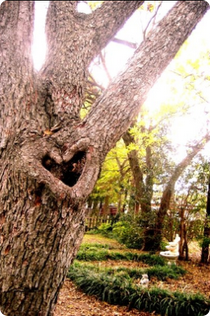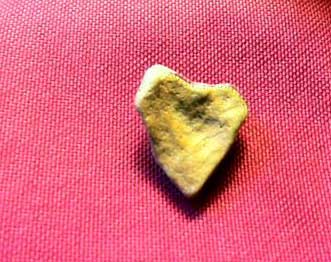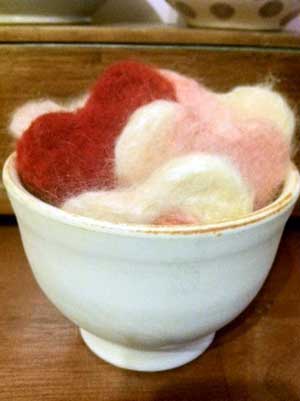 It is, perhaps, telling that my two favorite holidays are a) non-religious and b) associated with the acquisition of large amounts of candy. I love the autumnal, supernatural-tinged crispness of Halloween, and I adore Valentine’s Day’s pink, and red, and sparkles, and lace, and…hearts. I could live forever without the mushy sentiments. When I was single the romantic aspects of the holiday left me anguished, desperate and anxious for the relief that came on the 15th of February. Now that I am old and married, I am largely of the opinion that if you express your love only (or even mainly) because of Hallmark, you have some work to do on the home front. It is not the sentiment, but the trappings that “send” me.
It is, perhaps, telling that my two favorite holidays are a) non-religious and b) associated with the acquisition of large amounts of candy. I love the autumnal, supernatural-tinged crispness of Halloween, and I adore Valentine’s Day’s pink, and red, and sparkles, and lace, and…hearts. I could live forever without the mushy sentiments. When I was single the romantic aspects of the holiday left me anguished, desperate and anxious for the relief that came on the 15th of February. Now that I am old and married, I am largely of the opinion that if you express your love only (or even mainly) because of Hallmark, you have some work to do on the home front. It is not the sentiment, but the trappings that “send” me.
Although real, anatomical hearts are not particularly prepossessing as objects, they are beautiful in their own way. It would be hard to live without one. What I love, though, is the shape as old as the ice age, a shape that probably came from the combining of an ancient symbol for fire and that of the astrological sign Aries. It is, to my eyes, a perfect shape. It combines gentle curves for those who like curves, and they suggest other things that are rounded, erotic, comforting and otherwise love-worthy. For those who prefer straight lines and pointy things, there is everything below the curves, all straight lines and an exquisite point. Pentagrams are nifty, but they have nary a curve if the scribe is sober. The infinity symbol has two lovely, looping curves but what if one needs the crunchy edginess of a line or an acute angle?
 The heart is universally recognized regardless of language, easy to draw, and you can even make one with your hands if there isn’t a crayon handy. As a child, I loved making homemade valentines from red, pink and white construction paper, bits of lace, doilies and sparkly things. I was sad to discover that, by the time my son was old enough for school Valentine’s Day parties the hand crafting of valentines was largely a lost art; his classmates preferred tiny rectangles printed with images of Sponge Bob and Dora, the stubble of inadequate perforation marking them as the very opposite of homemade.
The heart is universally recognized regardless of language, easy to draw, and you can even make one with your hands if there isn’t a crayon handy. As a child, I loved making homemade valentines from red, pink and white construction paper, bits of lace, doilies and sparkly things. I was sad to discover that, by the time my son was old enough for school Valentine’s Day parties the hand crafting of valentines was largely a lost art; his classmates preferred tiny rectangles printed with images of Sponge Bob and Dora, the stubble of inadequate perforation marking them as the very opposite of homemade.
I tried, in vain, to interest him in making valentines from scratch, but he was a boy, and not a particularly artsy one. Defeated, I bought him cardboard boxes of cardboard valentines, supervising dutifully as he taped tiny boxes of Nerds to each card, writing the recipient’s name in his unintelligible hand.
 The adoration of the hearts is, then, left to me. I doodle them often, embellishing them with flowers, swirls and making concentric mandalas. I wear them as jewelry, and one of my most prized possessions is a heart-shaped stone found on the beach. It has always seemed to me to be a message from the cosmos, recognition of my love for the form and for the ocean that shaped it. At this time of year I make garlands of hearts; in the past they have been made from everything from old book pages to vintage fabric.
The adoration of the hearts is, then, left to me. I doodle them often, embellishing them with flowers, swirls and making concentric mandalas. I wear them as jewelry, and one of my most prized possessions is a heart-shaped stone found on the beach. It has always seemed to me to be a message from the cosmos, recognition of my love for the form and for the ocean that shaped it. At this time of year I make garlands of hearts; in the past they have been made from everything from old book pages to vintage fabric.
This year I am felting hearts from a braid of angora wool that varies from richest cream to the deep, velvety pink of a tea rose. They will probably be made into a garland, or I may secure a loop of ribbon to top of each one and pass them out to those I love. They are less fattening than chocolate, and after living in a box with a hand full of rose petals they will embody silky, fragrant gentleness – not a gift of passion, but one of deep and sincere love.
The history of Valentine’s Day and of St. Valentine himself is a murky mixture of tenuous attribution and pagan festivity. I prefer to see it as a time to think of warmth between friends, family and lovers, and a promise that beneath the hard, cold ground there is a quickening of the universe as it readies for the warmth of the sun in the coming spring. In that spirit, then, I offer you my hearts.
Ann Graham Nichols cooks and writes the Sprezzatura blog in East Lansing, Michigan where she lives in a 1912 house with her husband, her son and an improbable number of animals.

